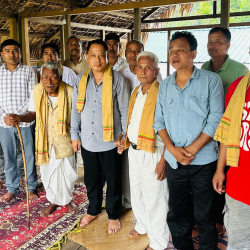The Sanskriti Anveshak forum of Vivekananda Kendra Institute of Culture, Guwahati organized a Lecture Series on: Cultural Pluralism: Focus Northeast India. The first talk of the series on the Arunachal Pradesh Perspective was organised on Friday, 25 May, 2012 at 5.30 pm. in the Williamson Magor Auditorium of the Institute at Uzan Bazar, Guwahati. The talk was delivered by Dr. Joram Begi, Director, Higher & Technical Education, Govt. of Arunachal Pradesh, Itanagar and Member, Research Advisory Council, VKIC. It was moderated by Prof AC Bhagabati, Honorary Coordinator & Head of the Division, North Eastern Regional Centre, Indira Gandhi National Centre for the Arts and Member, Research Advisory Council, VKIC.
Dr Joram Begi shared his views on the Pluralistic ethos of Arunachal Pradesh based on his experience of the communities. He said that he would prefer to use the phrase “Unity in Diversity” rather than the word “Cultural Pluralism” as the phrase has different meaning in the West which is not applicable to India.
He began with the genesis of the state of Arunachal Pradesh, of its rich flora and fauna, of the ethnic diversity of more than 26 major communities and 110 sub communities inhabiting the region. He stated that on the basis of socio- religious practices, these communities can be classified into two: those who follow established religions like Buddhism and those who follow the indigenous religion.
He said that both the Hinayana and Mahayana forms of Buddhism are practised amongst the Khampti, Singpho, Monpa, Sherdukpen, etc of Arunachal. Communities such as the Nocte, Tangsa, Wancho, Adi, Aka, etc follow the indigenous religion. that is variously called. It is the worship of the Sun and Moon that is prevalent in other parts of India also. Among them term to denote the Sun and the Moon might be different such as Rangfra, Donyi Polo, Intaya but the meaning is the same, with similar rituals and belief system.
Interestingly, the established religious faiths too have adapted several practices from the indigenous religion for instance offering of locally brewed rice beer during worship in a Buddhist shrine. Not only Buddhists, but Christians are observed to chant traditional mantra at times, replacing the name of the traditional deity with that of Jesus. A person belonging to a particular indigenous community would not hesitate to call a traditional priest belonging to another indigenous community in times of need. An intermingling of faith and people exist which is in tune with the wider spectrum of the Indian pluralistic spirit as the culture is one.
Dr. Begi said the cultural practices unique to Arunachal Pradesh are undergoing rapid changes due to the forces unleashed by the socio- economic changes. He appealed to all to initiate efforts to preserve it and asked the VKIC to organise similar programmes in Arunachal Pradesh to strengthen proper perspective on culture.
In the interactive session many questions were asked. One such question was on Verrier Elwin’s role in preserving Arunachal Pradesh’s way of life and protecting it from outside influence. Dr Begi acknowledged the Elwin’s good intentions but gave his informed opinion that on hindsight the people of Arunachal Pradesh have realized that Elwin’s policy was intended to make Arunachal a zoo or a museum at best. That is why it had failed for it is not through isolation but only through dynamic interaction can there be growth. To another question about Donyipoloism being made a state religion, Dr Begi made it clear that there was no such effort, rather every community – be it Adi, Tangsa, Nocte, Tagin, Aka, Mishmi, Nyishi, Galo, Apatani - is successfully drawing on its own traditional ways of worship and adapting it for continuity in an organised, institutionalized form. There is respect for one another’s way as equally true.
The Moderator of the session Prof. A.C Bhagabati, shared his experiences of Arunachal Pradesh mentioning the great diversity existing in Arunachal Pradesh yet at the same time pluralistic ethos prevalent in Arunachal in the sense, where everyone is allowed to express themselves without fear. He supplemented Dr Joram Begi on the need for the preservation of cultural practices of Arunachal Pradesh, stating that the historical and folklore resources need to be conserved for the good use in future. In a span of a few decades Arunachal Pradesh has undergone socio-economic and other changes that have taken place in the rest of the country over a few millennia, Dr Bhagabati said.
Earlier in the evening, Shri Dipok Kumar Barthakur, Chairman, VKIC welcomed the audience while Shri Rajesh Nair, Kendra Karyakarta introduced the guests.
- Sujatha Nayak
Secretary, Sanskriti Anveshak forum, Vivekananda Kendra Institute of Culture, Guwahati








Add new comment